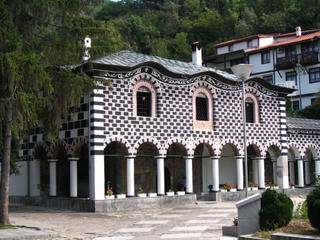
History lesson: In the late 9th century John of Rila (Ivan Rilski) took to the wilds of Bulgaria in search of solitude and enlightenment. According to the literature, John of Rila was a champion of the purity of the Christian Faith and of high moral standards. The hermit of Rila advocated equality between people, and the renunciation of wealth that has been acquired in unfair ways. His reform-minded ideas came to appeal to many and the cave in which he lived became a holy place for people from all over Bulgaria.


Shortly after his death in 946 he was canonized and because the bones of saints were important symbols that added legitimacy to the current ruler, Tsar Petar had St. John’s remains brought to Sofia. The bones were moved several times-- and the right hand took a tour of Russia to raise funds for the restoration of Bulgarian monasteries—but returned to Rila for good in 1469. The left had is on display in the current monastery church for a short period every day for “real” pilgrims. Gazing upon the hand (crossing one-self and kissing the glass) is said to bring a state of spiritual grace. [We were fortunate to be in the monastery church during the time the hand was displayed. People were clearly moved by this experience.]

A monastery was first built 4km west of St. John’s original hermitage in 1335. Several renovations have occurred as the monastery was plundered several times and experienced a fire in 1833.
As you can see from the pictures here, some bits are quite old (14-15th century) while other parts were built in the mid 20th century.


The outside walls of the monastery church are covered with the most beautiful frescos. They show the fall of Constantinople and visions of hell. The bat-winged demons that loom large in Bulgarian imagination are frequently displayed in somewhat gross detail. The pictures are displays of sin. If you can enlarge the one picture you can see some rich men eating while a poor beggar below the table has his leg being gnawed on by a dog. (I can enlarge a picture just by clicking on it.) Why the woman is being attacked by the demon is not clear.
The ceilings are also beautifully painted and include images of the “good guys.”(see two below)


There is a really nice museum connected to the monastery. No pictures were allowed. The highlight included a 14-inch high wooden cross made by the monk Rafail during the 1790s. It is composed of 140 tablets telling stories from the bible. There are more than 1500 figures carved in the tablets. It took Rafail 12 years to carve this (using a needle) and he went blind doing so.
We returned to Blagoevgrad this afternoon and after lunch in the square we walked by our local church in the "old town." It's not quite Rila, but it's pretty cool as well.


Until the next post, dovijdane! (PS: Sorry about the floating text. I have not quite figured out how to use this editor)

<< Home